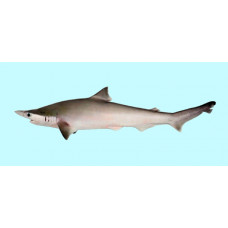Latin name
Scoliodon laticaudus
Other name
Scoliodon laticaudus
Identification
Body elongated, head broad with flattened muzzle. Eyes and nostrils small. The corners of the mouth are set back from the eyes, with poorly developed furrows at the corners. The jaws have 25-33 upper and 24-34 lower rows of teeth, each tooth having a narrow tip without teeth.
Features of fish fins
The first dorsal fin is closer to the pelvic fins than to the pectoral fins. The flippers are short and broad. The second dorsal fin is much smaller than the anal fin. There is no ridge between the first and second dorsal fins.
Fish colouring
The colouration is bronze-grey with a white belly. Fins are evenly coloured but may be darker than the body.
Distribution
Widespread in the western Indian and Pacific Oceans off the coasts of Bangladesh, Brunei, Cambodia, China, India, Indonesia, Japan, Macau, Malaysia, Myanmar, Oman, Pakistan, Philippines, Singapore, Somalia, Sri Lanka, Taiwan, Thailand and Vietnam.
Habitat
The spadenose shark is usually found close to the shore at a depth of 10-13 metres, often near rocky bottoms. It is also found in the lower reaches of rivers in Malaysia, Sumatra and Borneo, as it tolerates low salinity water.
Size
The maximum recorded length is 74 cm, although there are unconfirmed reports of individuals measuring 1.2 metres.
Behavior
In many areas these sharks can be found in large numbers and in large packs.
Food and feeding habits
They feed mainly on small bony fish such as anchovies, gobies and bombay ducks. Shrimps, crabs, squid and crustaceans are also sometimes included in their diet.
Reproduction
Spadenose sharks are viviparous and have one of the most advanced forms of placental live birth among fishes, as measured by the complexity of the placental attachment to the embryo and the weight difference between the egg and the newborn shark. Eggs measure 1 mm in diameter after ovulation, while the developed embryo is dependent on the mother and reaches a length of only 3 mm. The peculiar placenta, formed from the yolk sac, has an unusual columnar structure and is covered with a large number of long appendages that support a capillary network that provides a large surface area for gas exchange. The placental tissue contacts the uterine wall to form a unique structure, the "trophonematal cup", which consists of special appendages that transfer nutrients from the mother's blood to the embryo's blood.
Females give birth at least once a year. Breeding takes place throughout the year. Pregnancy lasts five to six months. Newborns are 12-15 cm in length. There are 6 to 18 offspring in a litter. Males reach sexual maturity at 24-36 cm and females at 33-35 cm. Sexual maturity occurs between six months and one year of age. Life expectancy is estimated at 5 years for males and 6 years for females.
Fishing
This species is targeted by artisanal and commercial fisheries throughout its range. Sharks are caught using fixed and floating gillnets, longlines, bottom nets, traps, trawls and hook-and-line nets.
Relationship with a person
Spadenose sharks are not dangerous to humans. Their meat is used as food and as bait for fishing. The fins are used for soup and the waste is made into fish meal.
| Classification | |
| Phylum | Chordata |
| Class | Chondrichthyes |
| Squad | Carcharhiniformes |
| Family | Carcharhinidae |
| Genus | Scoliodon |
| Species | S. laticaudus |
| Features | |
| Conservation status | Near Threatened |
| Habitat | Pelagic |
| Life span, years | 6 |
| Maximum body weight, kg | No information |
| Maximum length, cm | 74 |
| Sailing speed, m/s | No information |
| Threat to people | Edible |
| Way of eating | Predator |
Spadenose shark
Tags: spadenose shark

